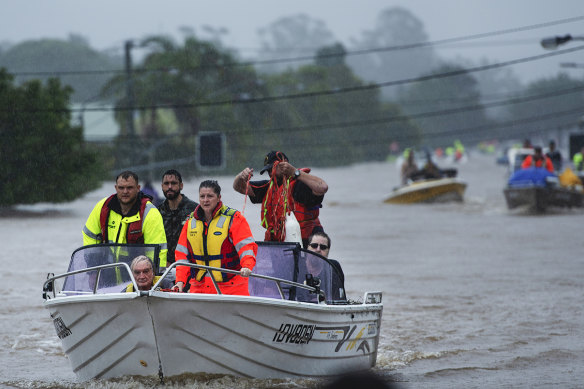By Nick O'Malley and Nigel Gladstone
The Bureau of Meteorology is battling stormy weather inside and out. Farmers, former employees and the union representing its staff say the agency’s decision-making, culture and communications are as clear as the mud that swamped communities along the east coast this year.
The national forecaster was put under extreme stress when a second La Nina period gave way to a third this year, creating a catastrophic combination of weather systems flooding 600 kilometres of Australia’s east coast. In the year to July, the bureau issued more than 5800 flood watches and warnings, triple its yearly average. By the time the summer floods receded across NSW, nine lives had been lost. Nationally, to November more than 250,000 insurance claims were made due to flooding.
Locals in Lismore felt let down by the bureau.Credit:Elise Derwin
The bureau aims for 97 per cent accuracy in its flood warnings. It fell slightly below that this year, at 94 per cent, but some misses were disastrous. In Lismore, locals complained that warnings they received from the bureau via the State Emergency Service came late and failed to predict the severity of the situation.
As the Herald and Age reported in June, Jane Golding, the hazard preparedness and response manager at the bureau, explained its performance by saying meteorology was an imprecise science.
“The forecast rainfall didn’t pick up the extremity of the event,” she said. “There are lots of different forms of computer models that we looked at. None of them really picked up … 775 millimetres in the headwaters of Lismore. The upper range for the Northern Rivers was between 200 and 400 millimetres.”
Last Sunday, National Farmers Federation vice-president David Jochinke was startled to learn that the bureau would soon replace meteorologists who conduct around 700 scheduled local radio crosses each week with spokespeople to be known as “community information officers”.
Jochinke, who spoke with the Herald and The Age from the cabin of his header as he harvested a canola crop on Thursday evening, opposes the change, saying that the presence of meteorologists on air was crucial to farmers, who often listened to their reports while working.
Farmers were able to text specific questions to the meteorologists via their ABC hosts, a key service that Jochinke does not believe “community information officers” will be able to replicate.
“The work of the bureau is crucial to agriculture in Australia, we don’t want to see it deteriorate,” he said.
“And they can’t tell us why they are doing it. If they want to specialise in communications, there’s a bit of 101 work they might want to get right first.”
The bureau said the National Farmers Federation had not raised any concerns directly with it about the radio broadcasts.
The way the move has been handled is reminiscent of the declaration in October that the organisation wished to be known henceforth as “The Bureau”.
The timing was awful. That month Victorians began to suffer. On Friday, October 14, the SES conducted 200 rescues, and another 114 the following day. Evacuation orders were issued for towns including Seymour, Rochester, Carisbrook and Wedderburn. By the following Tuesday, the threat had spread to Shepparton, Charlton and Echuca. Two people died in the Victorian floods.
The bureau announced a name change just as floods were sweeping across regional Victoria.Credit:NEARMAP
The announcement of a $220,000 rebranding in the midst of floods was catastrophic to the organisation’s reputation. It was condemned by commentators, criticised by Environment Minister Tanya Plibersek and lampooned on social media.
A bureau spokesman said that “like any large organisation, there are times when we don’t get it right”.
Behind the scenes, it served to compound the fury of some staff members who believed that poor management was damaging the institution.
Professor Scott Power, a senior principal research scientist who quit the bureau two years ago, says a culture of silence over climate change, in line with the views of the former government, has come to dominate parts of the agency.
“The director had this view, that I strongly disagreed with, that bureau focuses on [weather over] days to months and the CSIRO focuses on months to years,” Power says.
“My strong view, and the view shared by the World Meteorological Organisation and other prominent agencies, is that climate change is a really crucial matter and it’s perfectly appropriate for our national meteorological services to play a prominent role in addressing it.
“The CSIRO is not there to provide 24-hour services nationwide. They’re a research agency, whereas the Bureau of Meteorology is a national agency responsible for 24-hour services on issues related to meteorology and associated sciences.
“So it seems to me that Australia is not being served well by that approach to the problem.”
Covering 11 per cent of the planet from the tropics to Antarctica, the accuracy of the bureau’s weather model ranks consistently in the top four in the world, alongside those of the European Union, Britain and the United States, a bureau spokeswoman said.
The bureau’s seven-day forecasts today are as good as a four-day forecast about 20 years ago and a four-day forecast now is as good as a one-day forecast was in the 1980s.
Daily maximum temperature predictions were accurate to within 2 degrees of actual temperatures 89.4 per cent of the time in 2021-22, five per cent better than 15 years ago.
Rainfall is harder to predict than temperature, as it falls in smaller areas at varying rates, but the bureau’s forecasts there have improved too.
“The quality of our flood forecasts, measured through peak accuracy and forecast lead-time, have overall improved and are within 10 per cent of targets [agreed with state and territory agencies],” a bureau spokeswoman said.
However, the bureau’s rainfall prediction accuracy for the NSW coast and Sydney regions in September was among the worst results for the region last year.
The bureau’s flood forecast peak predictions aim to be within 0.3 metres 70 per cent of the time, but in 2021-22 that mark was met just 68 per cent of the time, down from 81 per cent in 2019-20 and 71 per cent in 2020-21.
The bureau’s work did help mitigate about $283.5 million in damage from severe weather events last year, based on Insurance Council of Australia data showing $2.12 billion in insured losses from bushfires, floods, tropical cyclones and thunderstorms.
But for all the things it gets right, internally the bureau is under pressure. Beth Vincent-Pietsch, deputy secretary of the Community and Public Sector Union, says morale has been battered by the decision to move many forecasters from regional centres to capital cities. “They say it was to improve services, but we believe it is a cost-saving measure,” she says.
The union says the bureau is underfunded. In 2019, a KPMG report showed the bureau’s budget was forecast to decline between 2019-20 and 2022-2023 from $334 million to $266 million at the same time it capital funding was set to decline. However, funding has been increased recently. The union says bureau staff are struggling with workloads exacerbated by extreme weather events.
A June 2022 survey of 1485 people working at the bureau – about three-quarters of the workforce – found the majority didn’t agree that senior executives communicated with staff effectively, and disagreed that senior management was working as a team.
Almost one in three people surveyed also disagreed that their workgroup had the “tools and resources needed to perform well”.
The bureau pointed to recent independent culture surveys, “organisational pulse checks” and a “range of health and safety and human resources indicators” reporting a strong workplace culture.
“We are acutely aware that the sustained periods of severe weather over large areas mean that this year has been a challenging period for all of our people,” a bureau spokesman said. “We are committed to promoting a healthy, safe and productive workplace, and we continue to provide support to our people as they deal with the very many personal and professional challenges resulting from COVID and sustained severe weather.”
Professor David Karoly, a veteran climate scientist who worked closely with bureau staff while at the CSIRO Earth Systems and Climate Change Hub, says the politicisation of the climate change debate is still being felt inside the bureau.
He says scientists with profound knowledge of climate change impacts on Australia have been ordered not to speak to the media about the subject by senior management.
“My guess is that’s at least in part related to a risk-averse management style that began under the previous government,” Karoly adds.
The bureau is studying connections between climate change and extreme rainfall, extreme fire and extreme heatwaves, and its reports and studies predict further increases in extreme events, he says: “But for reasons that I don’t fully understand the Bureau of Meteorology management has wanted those risks to not be publicly described by bureau scientists.”
Silencing its own experts was a disservice to the nation and has battered morale within the organisation, he says.
A former staff member, who asked not to be named, said every request from the media to speak with meteorologists has to be thoroughly vetted and approved at such senior levels that the release of critical information is often delayed.
“We are a public service, and we believe in serving the public, and we were prevented from doing that,” the source said.
A bureau spokesman said their “extensive findings and statements on climate change are publicly available, and this work informs the economic, environmental and social decisions of governments, industries and communities”.
“Work relating to climate change occurs in nearly every part of the bureau,” he added.
Get to the heart of what’s happening with climate change and the environment. Our fortnightly Environment newsletter brings you the news, the issues and the solutions. Sign up here.
Most Viewed in Environment
Source: Read Full Article








